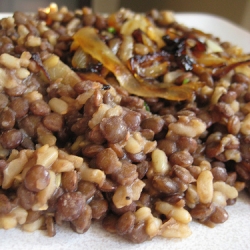Food Matters: Bread and Salt
by Kristin Hamaker
A couple years ago there was a beautiful and moving article in The New York Times called “The Flavors That Unite Syrians” by Dalia Mortada, a journalist reporting from Istanbul covering the civil war in Syria. In her article she reminds us that food can tell us far more about a culture and its people than say, a news article. In meeting with Syrian refugees she was regularly folded into their meals, however modest, and found that these dishes and flavors became the material by which she would deliver their stories.
This set me to thinking that when I began studying art history in college, for the first time I began to understand the history of cultures in a way I never could absorb in high school text books. It was through art and literature, and later through food, that I have come to appreciate the world.
Bread and Salt: I learned this custom after reading Mortada’s piece, and learned it is a greeting and a tradition in numerous European cultures, a custom she found herself a part of as she traveled. Simply, a bit of bread offered to a visitor, along with a pinch of salt, symbolizes welcome, hospitality, alliance, and gratitude. The breaking of bread, with or without salt, is something sorely needed as we pass into a seemingly more divided world.
In a time when it is hard to know how to be engaged, we can at least do this: cook. And certainly find meaning there. But what if we went a step further, and made a dish from a culture that is under siege, to honor those dishes and stories, to honor those who are displaced? This week I will make a dish from Claudia Roden’s The New Book of Middle Eastern Food, a book I’ve admired for a long time, a book that goes down like a collection of short stories. Meat dumplings in yogurt sauce? Bean and vegetable soup? Plain rice, perhaps.
Maybe you are like me, coming to understand more and more that what we eat matters. That what we eat and cook and share can offer us meaning and connection in the most unexpected of ways, and in the darkest and lightest of times.
Here is a modest recipe, from a one such faraway place, that captures the spirit.
Kristin is a chef, meal planner, and the founder of Goosefoot Kitchen. She teaches, writes on, and advocates for the good life in and around the kitchen and at the table.
Mujadarrah: Lentils w/ Rice, Carmelized Onions
There was this one family I cooked for — in my personal chef days — who adored this seemingly plain dish, and would ask for it time and again. Recollecting that brings a smile since this dish reflects what I love most: simple and healthy recipes that are humble, but easily move into sophistication. This dish has a long tradition in the Middle East, and is a perfect vegetarian supper. Serve it alone (with a dollop of yogurt, perhaps), or as a side dish, with a cold salad, but certainly warmed up for lunch the next day.
Market List
• 2 large yellow onions
• Extra virgin olive oil
• Kosher or sea salt and black pepper
• 1 ¼ cup green or brown lentils
• 1 cup long grain rice
Slow Onions
Slice 2 large yellow onions, and turn on a medium-low heat under a large skillet. Once hot, add ¼ cup of extra virgin olive oil. Add your onion, and a good pinch of kosher or sea salt, and partially cover until they’ve softened, about 10 minutes.
Lentils
In the meantime, rinse 1 ¼ cup of green or brown lentils (my favorite are French green). (Soaking your lentils ahead for around an hour will assist in their even cooking and digestion, but it is not necessary.) Add them to a saucepan and cover with 4 cups of water and a good pinch of kosher or sea salt. Bring to a boil, and allow them to simmer for 15 minutes.
Keep Going Onions
Remove the lid from your onions, turn the heat up to medium, and allow them to cook for a further 15 minutes, stirring frequently. At this point they may have become tender and browned; allow more time if this hasn’t happened yet. (The longer the onions have to cook the more developed their flavor will be, and you can simply let them cook until dinner is ready if you like; but turn down your heat to low if the onions are darkening too much, or burning.)
Rice, a Perfect Partner
After your lentils have simmered for 15 minutes, add 1 cup long grain rice, a pinch of kosher or sea salt, and a good twist of black pepper to the saucepan. Stir, then cover and cook over low heat until the rice and lentils are tender, about 15-20 minutes. Add additional water along the way, if needed, to keep it just covered and moistened.
Finish
Stir half of the caramelized onion into the lentils and rice, cover, and let that stand off the heat for a few minutes. Serve in large, shallow bowls and top each with the remaining onions, and drizzle any remaining oil from the pan over top. Serve with a dollop of plain yogurt, if you like.
NOTES & VARIATIONS
• To further enhance the flavor of this dish: add 1 tablespoon of tomato paste and ½ teaspoon dried pepper flakes to the water with the lentils, and/or add 1 teaspoon cumin and/or coriander, or 2 teaspoons of dried mint to the water with the lentils.
• Replace rice with bulgur to vary this recipe. And replace the green or brown lentils with red lentils if you wish. Red lentils will cook a bit more quickly, and will break down into more of a puree.




